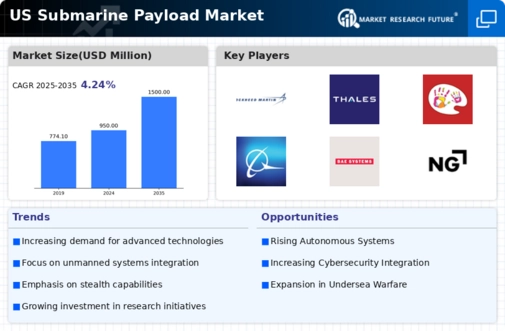The US Submarine Payload Market represents a critical niche within the arms and defense sector, characterized by rapid technological advancements, intense competition, and evolving warfare strategies. As nations seek enhanced underwater capabilities, the market's dynamics are increasingly influenced by the demand for advanced payload systems including weaponry, surveillance, and communications technology. The complexity of underwater operations necessitates innovative solutions that can be adapted to various submarine classes and missions.
Recognizing the pivotal role that these underwater platforms play in national security, various players in the market are striving to develop and deliver superior payload solutions that can withstand the rigors of modern naval conflict, while maintaining operational effectiveness and efficiency.Raytheon Technologies stands out as a significant player in the US submarine payload market, known for its robust array of technologies and defense capabilities. The company excels in developing advanced sensors, weapons, and electronic warfare systems specifically tailored for submarine applications.
Its strengths lie not only in its technological innovation but also in its strategic partnerships with the US Navy and other defense entities, allowing it to align closely with government defense priorities. Raytheon Technologies leverages detailed market intelligence to anticipate shifts in defense expenditure and technology requirements, making it a poised competitor in delivering payload solutions that enhance the capabilities of submarine fleets.
Its commitment to research and development ensures that the company remains at the forefront of advancements in payload technology applicable to underwater missions, bolstering its market presence in this segment.Huntington Ingalls Industries is another prominent entity within the US submarine payload market, recognized for its extensive experience in shipbuilding and defense systems integration. Known for constructing the US Navy's fleet of submarines, the company complements its building capabilities with a focus on integrated payload systems that enhance submarine functionality.
Huntington Ingalls Industries offers a variety of key products, including sophisticated combat and control systems that improve the operational effectiveness of submarines. The company has shown strength in adapting its manufacturing processes and technological offerings to meet evolving defense requirements, ensuring impactful contributions to US naval capabilities. Moreover, through strategic mergers and acquisitions, Huntington Ingalls Industries has expanded its portfolio and technology base, positioning itself effectively in the competitive landscape of underwater payload solutions, reinforcing its standing in the US defense market.



















Leave a Comment